MBA402, Semester 2: A Code of Conduct Report for ANZ Bank
VerifiedAdded on 2022/09/07
|13
|2789
|28
Report
AI Summary
This report presents a detailed Code of Conduct for ANZ Bank, fulfilling the requirements of an MBA402 assignment. It comprehensively addresses key areas of corporate governance, ethics, and sustainability, including discrimination, exploitation, corruption, dishonest and fraudulent behavior, whistleblower protections, and enforcement. The report draws upon recent news articles and academic sources to provide a thorough analysis and practical guidelines. It outlines specific measures and policies ANZ Bank should implement to ensure ethical conduct, prevent misconduct, and maintain a strong governance framework. The report emphasizes the importance of transparency, integrity, and respect within the organization, while also addressing legal and regulatory compliance. The code of conduct provides recommendations for fostering a culture of ethical behavior and accountability within the bank. It also includes a discussion of enforcement mechanisms and the role of the Office of Comptroller of Currency (OCC).
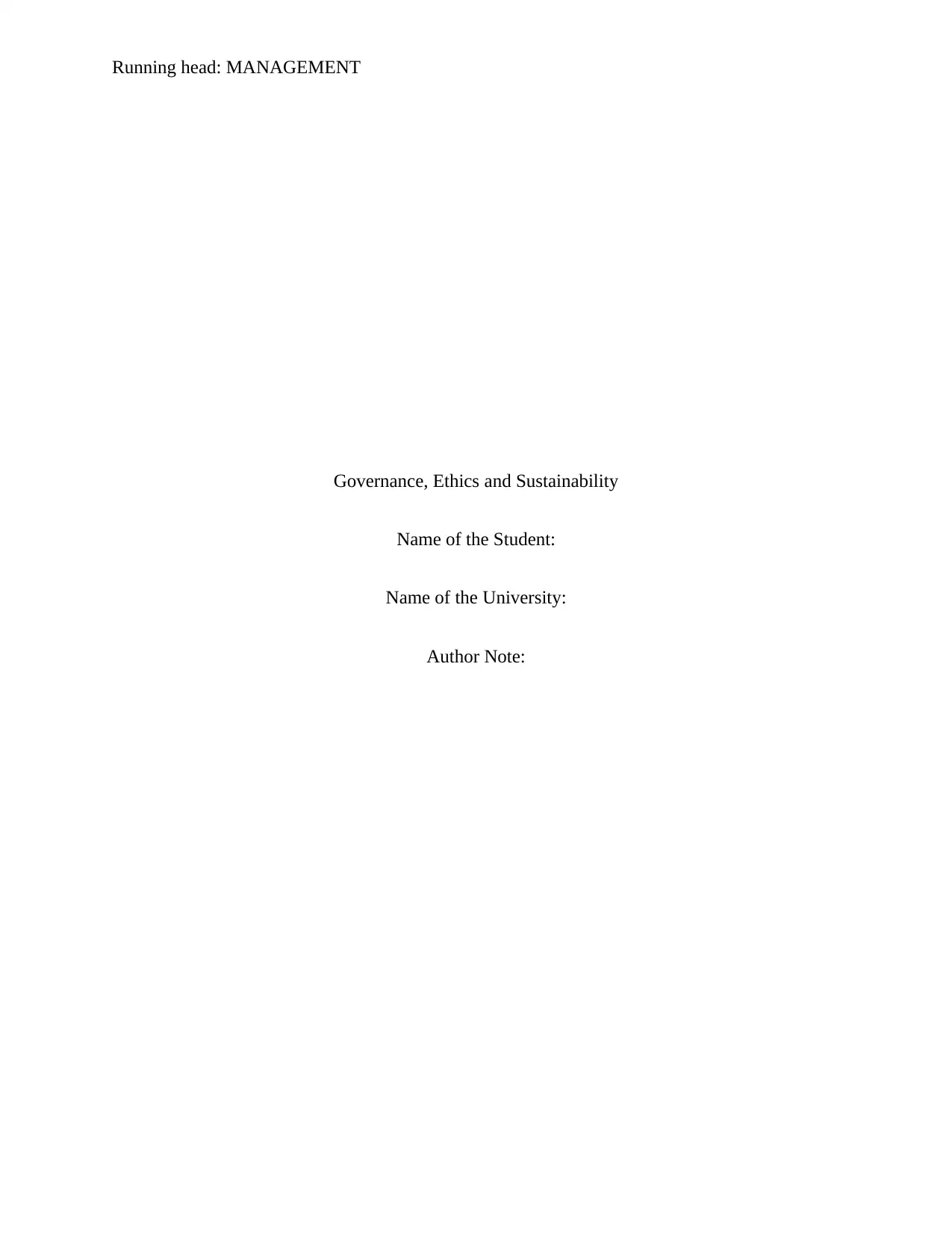
Running head: MANAGEMENT
Governance, Ethics and Sustainability
Name of the Student:
Name of the University:
Author Note:
Governance, Ethics and Sustainability
Name of the Student:
Name of the University:
Author Note:
Paraphrase This Document
Need a fresh take? Get an instant paraphrase of this document with our AI Paraphraser
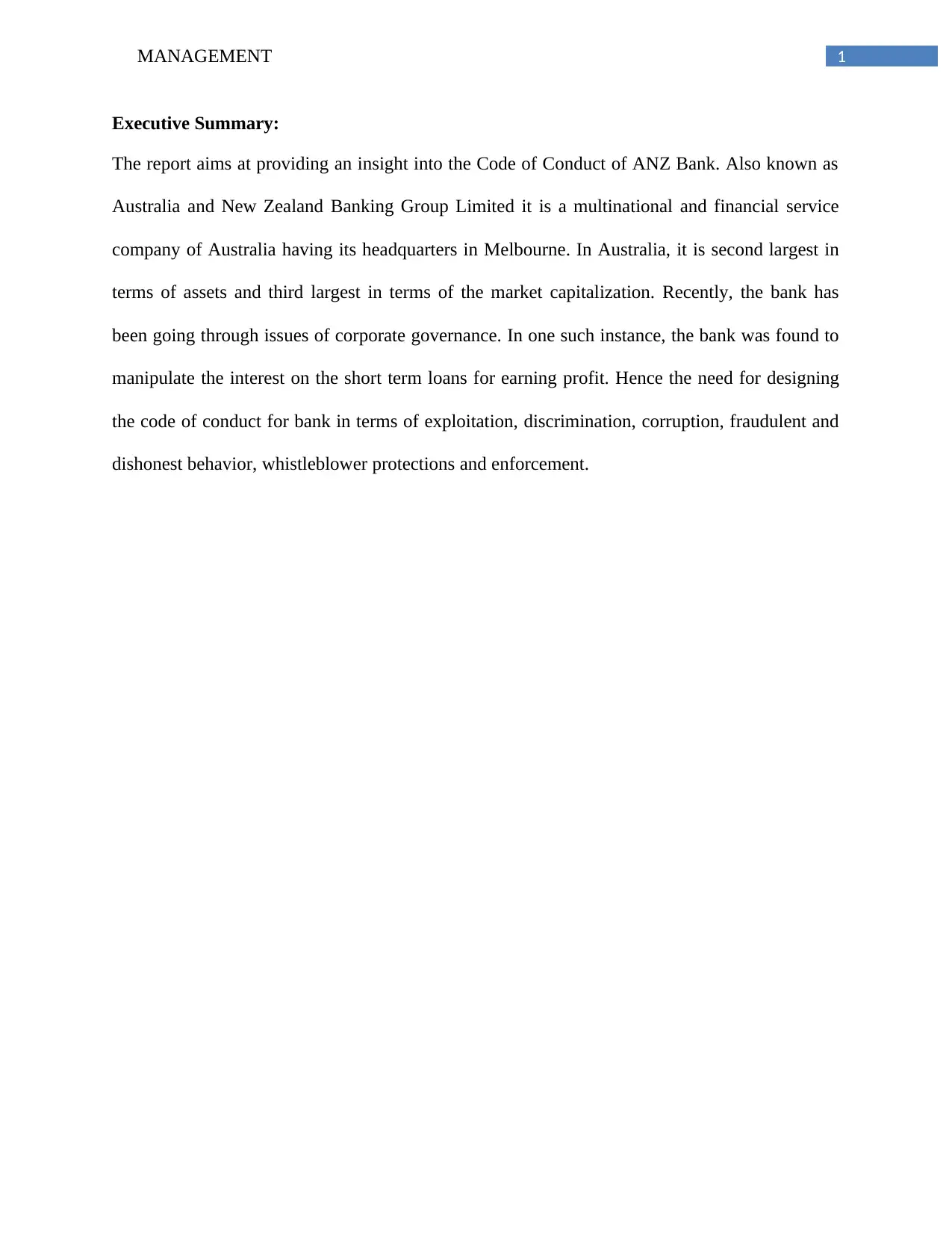
1MANAGEMENT
Executive Summary:
The report aims at providing an insight into the Code of Conduct of ANZ Bank. Also known as
Australia and New Zealand Banking Group Limited it is a multinational and financial service
company of Australia having its headquarters in Melbourne. In Australia, it is second largest in
terms of assets and third largest in terms of the market capitalization. Recently, the bank has
been going through issues of corporate governance. In one such instance, the bank was found to
manipulate the interest on the short term loans for earning profit. Hence the need for designing
the code of conduct for bank in terms of exploitation, discrimination, corruption, fraudulent and
dishonest behavior, whistleblower protections and enforcement.
Executive Summary:
The report aims at providing an insight into the Code of Conduct of ANZ Bank. Also known as
Australia and New Zealand Banking Group Limited it is a multinational and financial service
company of Australia having its headquarters in Melbourne. In Australia, it is second largest in
terms of assets and third largest in terms of the market capitalization. Recently, the bank has
been going through issues of corporate governance. In one such instance, the bank was found to
manipulate the interest on the short term loans for earning profit. Hence the need for designing
the code of conduct for bank in terms of exploitation, discrimination, corruption, fraudulent and
dishonest behavior, whistleblower protections and enforcement.
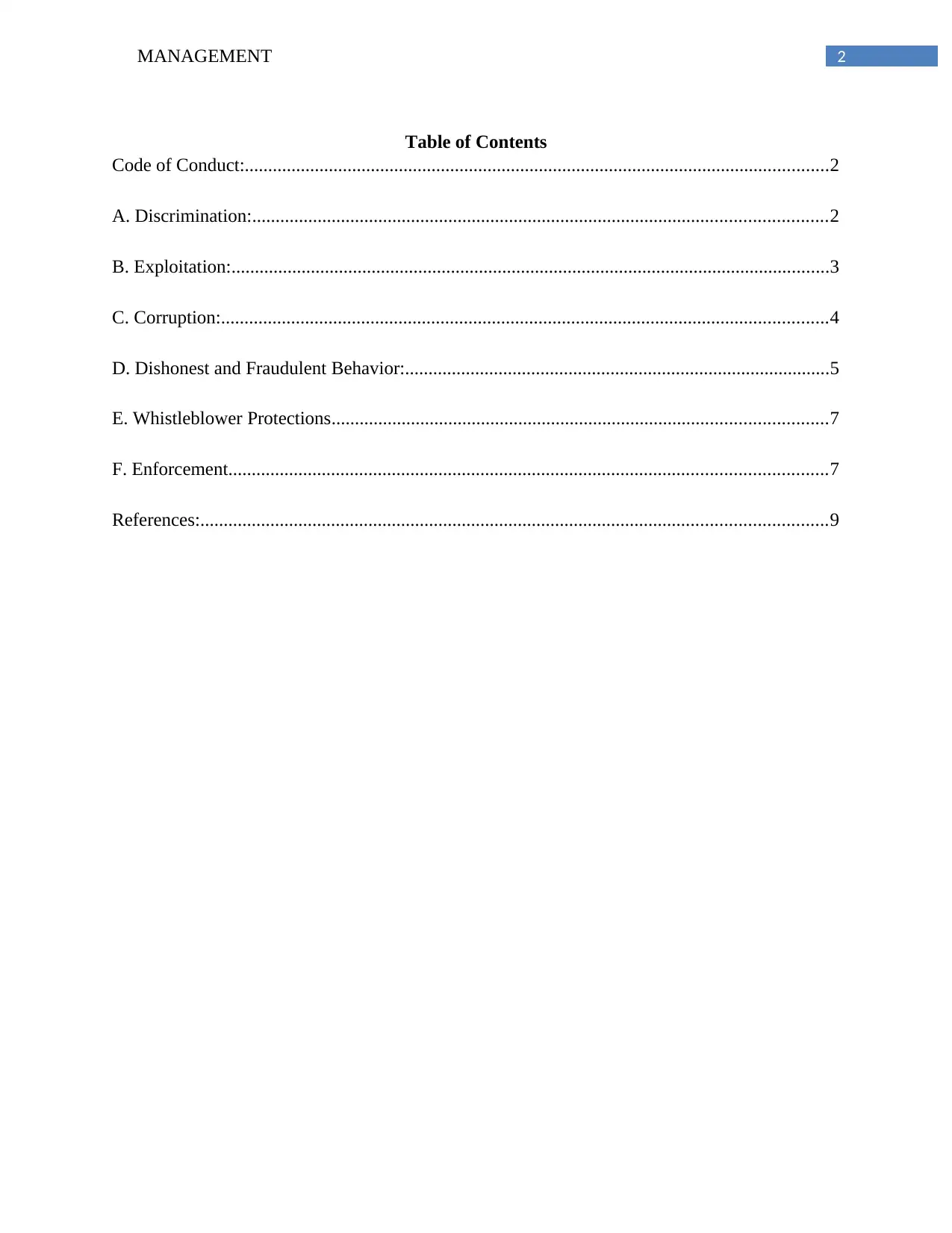
2MANAGEMENT
Table of Contents
Code of Conduct:.............................................................................................................................2
A. Discrimination:...........................................................................................................................2
B. Exploitation:................................................................................................................................3
C. Corruption:..................................................................................................................................4
D. Dishonest and Fraudulent Behavior:...........................................................................................5
E. Whistleblower Protections..........................................................................................................7
F. Enforcement................................................................................................................................7
References:......................................................................................................................................9
Table of Contents
Code of Conduct:.............................................................................................................................2
A. Discrimination:...........................................................................................................................2
B. Exploitation:................................................................................................................................3
C. Corruption:..................................................................................................................................4
D. Dishonest and Fraudulent Behavior:...........................................................................................5
E. Whistleblower Protections..........................................................................................................7
F. Enforcement................................................................................................................................7
References:......................................................................................................................................9
⊘ This is a preview!⊘
Do you want full access?
Subscribe today to unlock all pages.

Trusted by 1+ million students worldwide
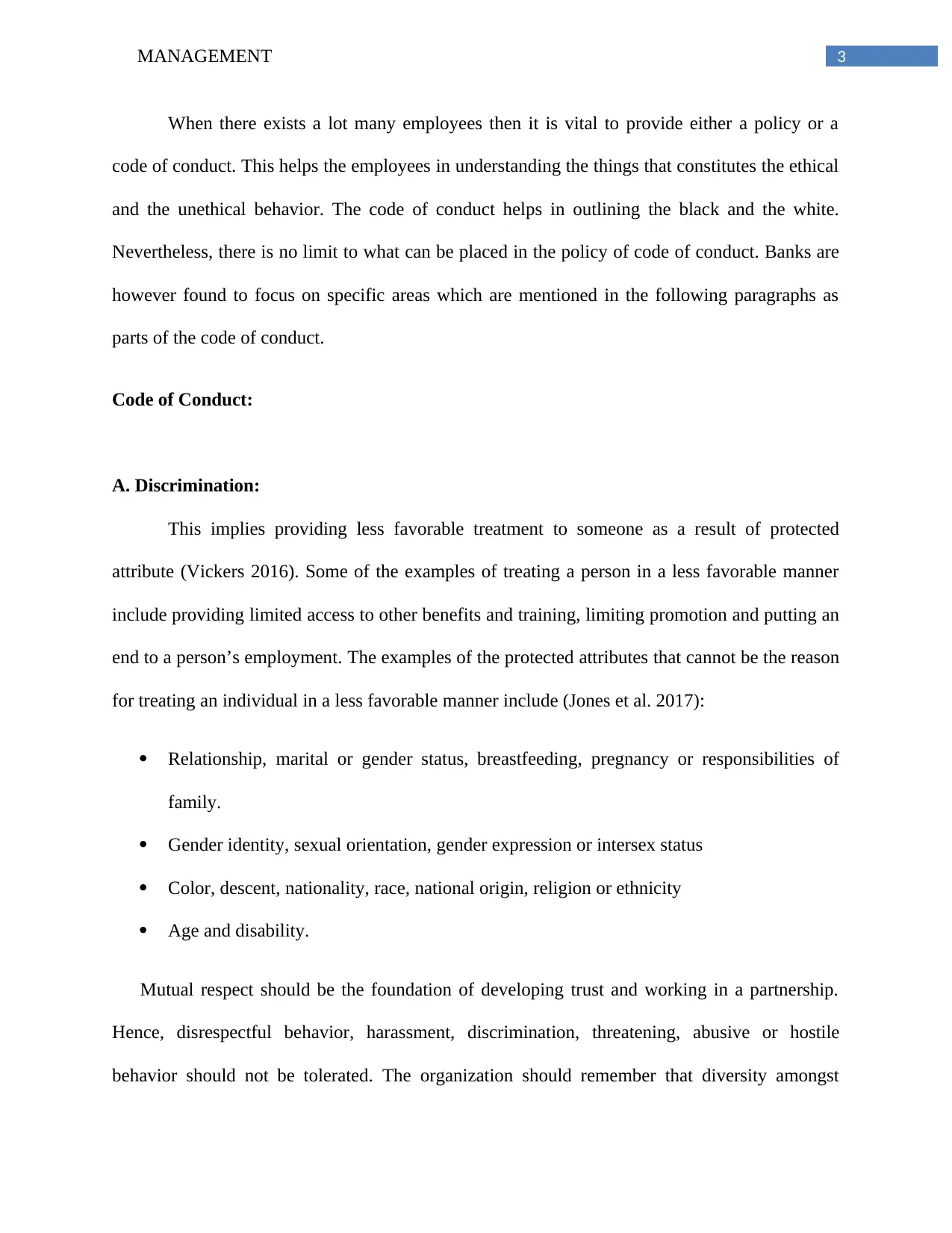
3MANAGEMENT
When there exists a lot many employees then it is vital to provide either a policy or a
code of conduct. This helps the employees in understanding the things that constitutes the ethical
and the unethical behavior. The code of conduct helps in outlining the black and the white.
Nevertheless, there is no limit to what can be placed in the policy of code of conduct. Banks are
however found to focus on specific areas which are mentioned in the following paragraphs as
parts of the code of conduct.
Code of Conduct:
A. Discrimination:
This implies providing less favorable treatment to someone as a result of protected
attribute (Vickers 2016). Some of the examples of treating a person in a less favorable manner
include providing limited access to other benefits and training, limiting promotion and putting an
end to a person’s employment. The examples of the protected attributes that cannot be the reason
for treating an individual in a less favorable manner include (Jones et al. 2017):
Relationship, marital or gender status, breastfeeding, pregnancy or responsibilities of
family.
Gender identity, sexual orientation, gender expression or intersex status
Color, descent, nationality, race, national origin, religion or ethnicity
Age and disability.
Mutual respect should be the foundation of developing trust and working in a partnership.
Hence, disrespectful behavior, harassment, discrimination, threatening, abusive or hostile
behavior should not be tolerated. The organization should remember that diversity amongst
When there exists a lot many employees then it is vital to provide either a policy or a
code of conduct. This helps the employees in understanding the things that constitutes the ethical
and the unethical behavior. The code of conduct helps in outlining the black and the white.
Nevertheless, there is no limit to what can be placed in the policy of code of conduct. Banks are
however found to focus on specific areas which are mentioned in the following paragraphs as
parts of the code of conduct.
Code of Conduct:
A. Discrimination:
This implies providing less favorable treatment to someone as a result of protected
attribute (Vickers 2016). Some of the examples of treating a person in a less favorable manner
include providing limited access to other benefits and training, limiting promotion and putting an
end to a person’s employment. The examples of the protected attributes that cannot be the reason
for treating an individual in a less favorable manner include (Jones et al. 2017):
Relationship, marital or gender status, breastfeeding, pregnancy or responsibilities of
family.
Gender identity, sexual orientation, gender expression or intersex status
Color, descent, nationality, race, national origin, religion or ethnicity
Age and disability.
Mutual respect should be the foundation of developing trust and working in a partnership.
Hence, disrespectful behavior, harassment, discrimination, threatening, abusive or hostile
behavior should not be tolerated. The organization should remember that diversity amongst
Paraphrase This Document
Need a fresh take? Get an instant paraphrase of this document with our AI Paraphraser
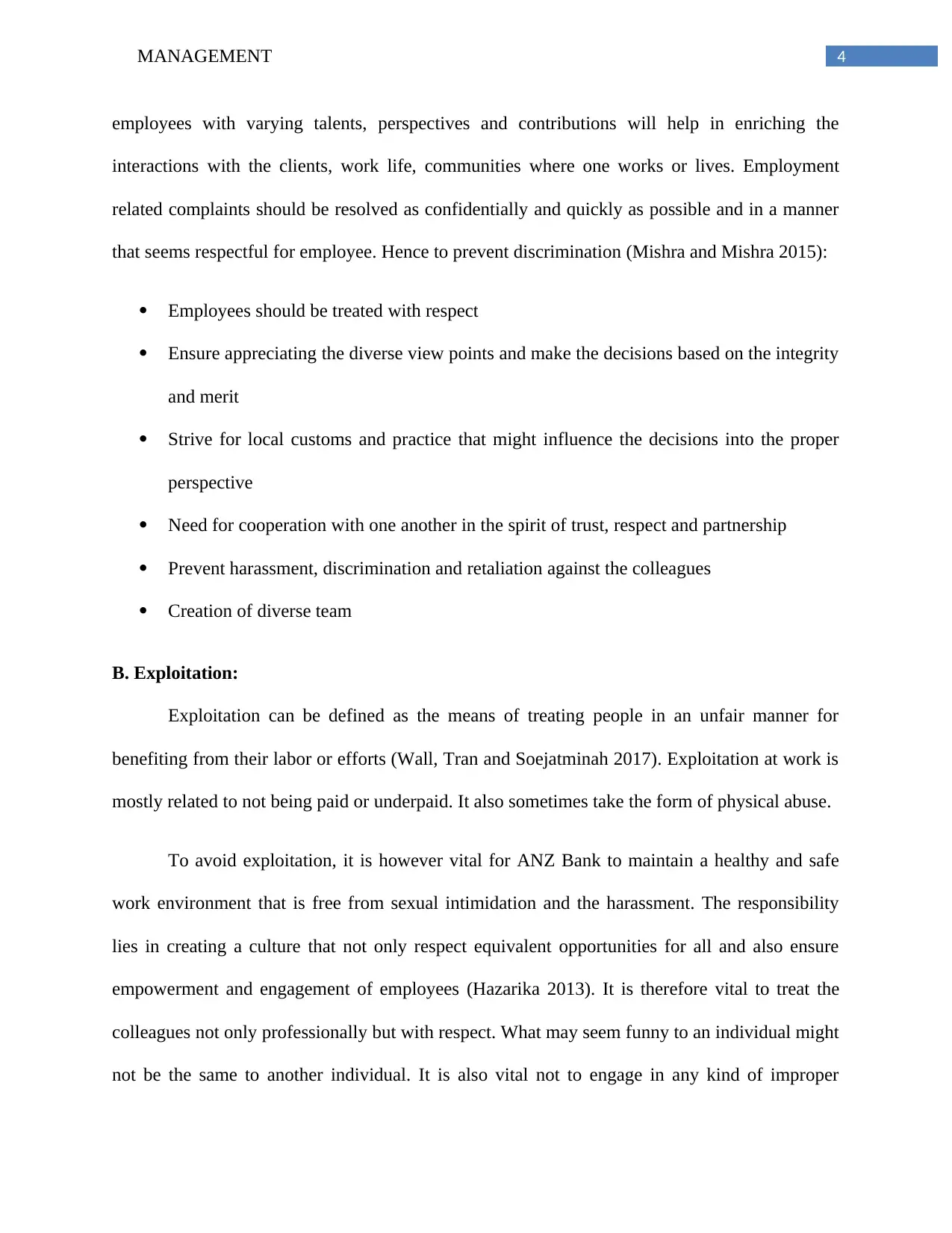
4MANAGEMENT
employees with varying talents, perspectives and contributions will help in enriching the
interactions with the clients, work life, communities where one works or lives. Employment
related complaints should be resolved as confidentially and quickly as possible and in a manner
that seems respectful for employee. Hence to prevent discrimination (Mishra and Mishra 2015):
Employees should be treated with respect
Ensure appreciating the diverse view points and make the decisions based on the integrity
and merit
Strive for local customs and practice that might influence the decisions into the proper
perspective
Need for cooperation with one another in the spirit of trust, respect and partnership
Prevent harassment, discrimination and retaliation against the colleagues
Creation of diverse team
B. Exploitation:
Exploitation can be defined as the means of treating people in an unfair manner for
benefiting from their labor or efforts (Wall, Tran and Soejatminah 2017). Exploitation at work is
mostly related to not being paid or underpaid. It also sometimes take the form of physical abuse.
To avoid exploitation, it is however vital for ANZ Bank to maintain a healthy and safe
work environment that is free from sexual intimidation and the harassment. The responsibility
lies in creating a culture that not only respect equivalent opportunities for all and also ensure
empowerment and engagement of employees (Hazarika 2013). It is therefore vital to treat the
colleagues not only professionally but with respect. What may seem funny to an individual might
not be the same to another individual. It is also vital not to engage in any kind of improper
employees with varying talents, perspectives and contributions will help in enriching the
interactions with the clients, work life, communities where one works or lives. Employment
related complaints should be resolved as confidentially and quickly as possible and in a manner
that seems respectful for employee. Hence to prevent discrimination (Mishra and Mishra 2015):
Employees should be treated with respect
Ensure appreciating the diverse view points and make the decisions based on the integrity
and merit
Strive for local customs and practice that might influence the decisions into the proper
perspective
Need for cooperation with one another in the spirit of trust, respect and partnership
Prevent harassment, discrimination and retaliation against the colleagues
Creation of diverse team
B. Exploitation:
Exploitation can be defined as the means of treating people in an unfair manner for
benefiting from their labor or efforts (Wall, Tran and Soejatminah 2017). Exploitation at work is
mostly related to not being paid or underpaid. It also sometimes take the form of physical abuse.
To avoid exploitation, it is however vital for ANZ Bank to maintain a healthy and safe
work environment that is free from sexual intimidation and the harassment. The responsibility
lies in creating a culture that not only respect equivalent opportunities for all and also ensure
empowerment and engagement of employees (Hazarika 2013). It is therefore vital to treat the
colleagues not only professionally but with respect. What may seem funny to an individual might
not be the same to another individual. It is also vital not to engage in any kind of improper
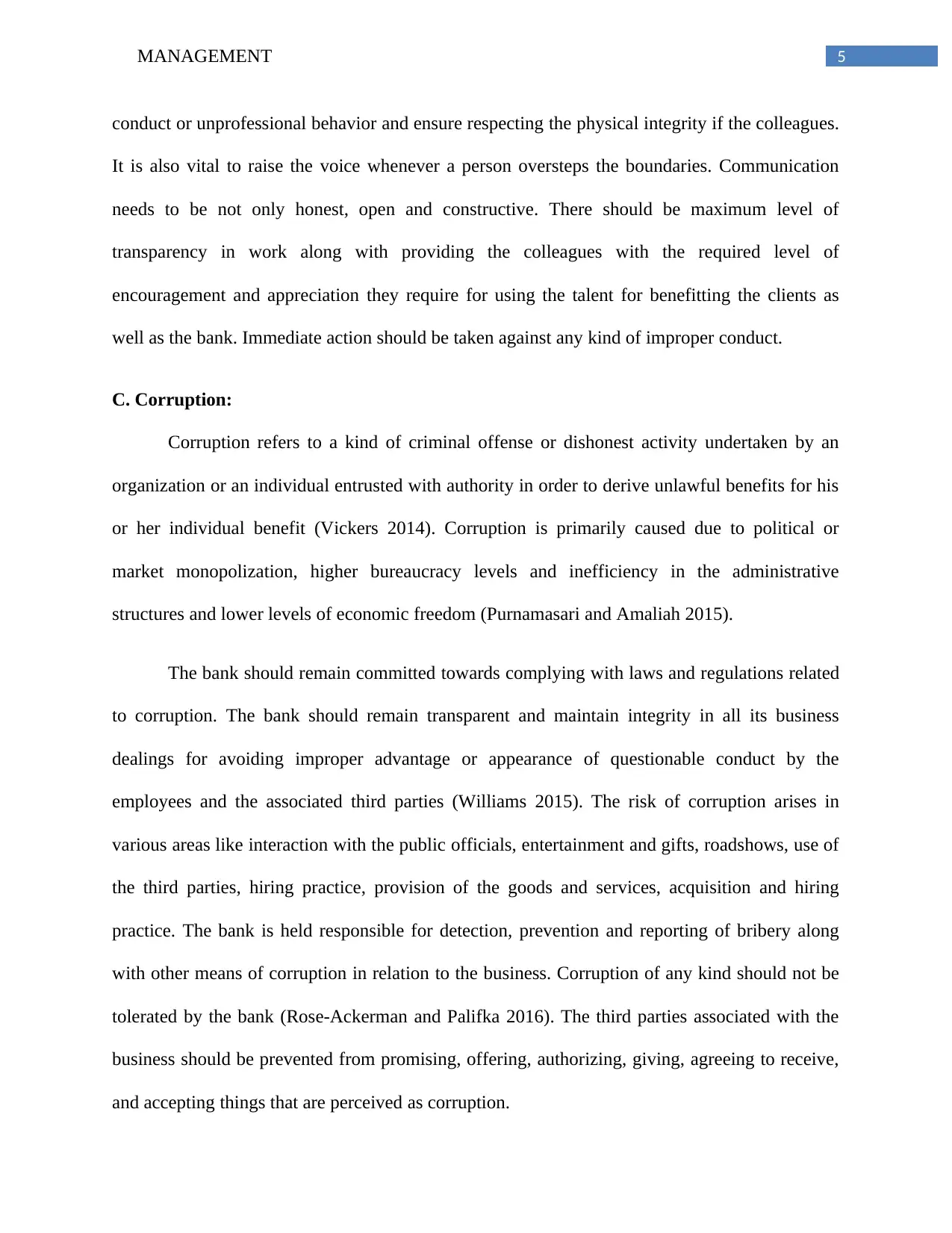
5MANAGEMENT
conduct or unprofessional behavior and ensure respecting the physical integrity if the colleagues.
It is also vital to raise the voice whenever a person oversteps the boundaries. Communication
needs to be not only honest, open and constructive. There should be maximum level of
transparency in work along with providing the colleagues with the required level of
encouragement and appreciation they require for using the talent for benefitting the clients as
well as the bank. Immediate action should be taken against any kind of improper conduct.
C. Corruption:
Corruption refers to a kind of criminal offense or dishonest activity undertaken by an
organization or an individual entrusted with authority in order to derive unlawful benefits for his
or her individual benefit (Vickers 2014). Corruption is primarily caused due to political or
market monopolization, higher bureaucracy levels and inefficiency in the administrative
structures and lower levels of economic freedom (Purnamasari and Amaliah 2015).
The bank should remain committed towards complying with laws and regulations related
to corruption. The bank should remain transparent and maintain integrity in all its business
dealings for avoiding improper advantage or appearance of questionable conduct by the
employees and the associated third parties (Williams 2015). The risk of corruption arises in
various areas like interaction with the public officials, entertainment and gifts, roadshows, use of
the third parties, hiring practice, provision of the goods and services, acquisition and hiring
practice. The bank is held responsible for detection, prevention and reporting of bribery along
with other means of corruption in relation to the business. Corruption of any kind should not be
tolerated by the bank (Rose-Ackerman and Palifka 2016). The third parties associated with the
business should be prevented from promising, offering, authorizing, giving, agreeing to receive,
and accepting things that are perceived as corruption.
conduct or unprofessional behavior and ensure respecting the physical integrity if the colleagues.
It is also vital to raise the voice whenever a person oversteps the boundaries. Communication
needs to be not only honest, open and constructive. There should be maximum level of
transparency in work along with providing the colleagues with the required level of
encouragement and appreciation they require for using the talent for benefitting the clients as
well as the bank. Immediate action should be taken against any kind of improper conduct.
C. Corruption:
Corruption refers to a kind of criminal offense or dishonest activity undertaken by an
organization or an individual entrusted with authority in order to derive unlawful benefits for his
or her individual benefit (Vickers 2014). Corruption is primarily caused due to political or
market monopolization, higher bureaucracy levels and inefficiency in the administrative
structures and lower levels of economic freedom (Purnamasari and Amaliah 2015).
The bank should remain committed towards complying with laws and regulations related
to corruption. The bank should remain transparent and maintain integrity in all its business
dealings for avoiding improper advantage or appearance of questionable conduct by the
employees and the associated third parties (Williams 2015). The risk of corruption arises in
various areas like interaction with the public officials, entertainment and gifts, roadshows, use of
the third parties, hiring practice, provision of the goods and services, acquisition and hiring
practice. The bank is held responsible for detection, prevention and reporting of bribery along
with other means of corruption in relation to the business. Corruption of any kind should not be
tolerated by the bank (Rose-Ackerman and Palifka 2016). The third parties associated with the
business should be prevented from promising, offering, authorizing, giving, agreeing to receive,
and accepting things that are perceived as corruption.
⊘ This is a preview!⊘
Do you want full access?
Subscribe today to unlock all pages.

Trusted by 1+ million students worldwide
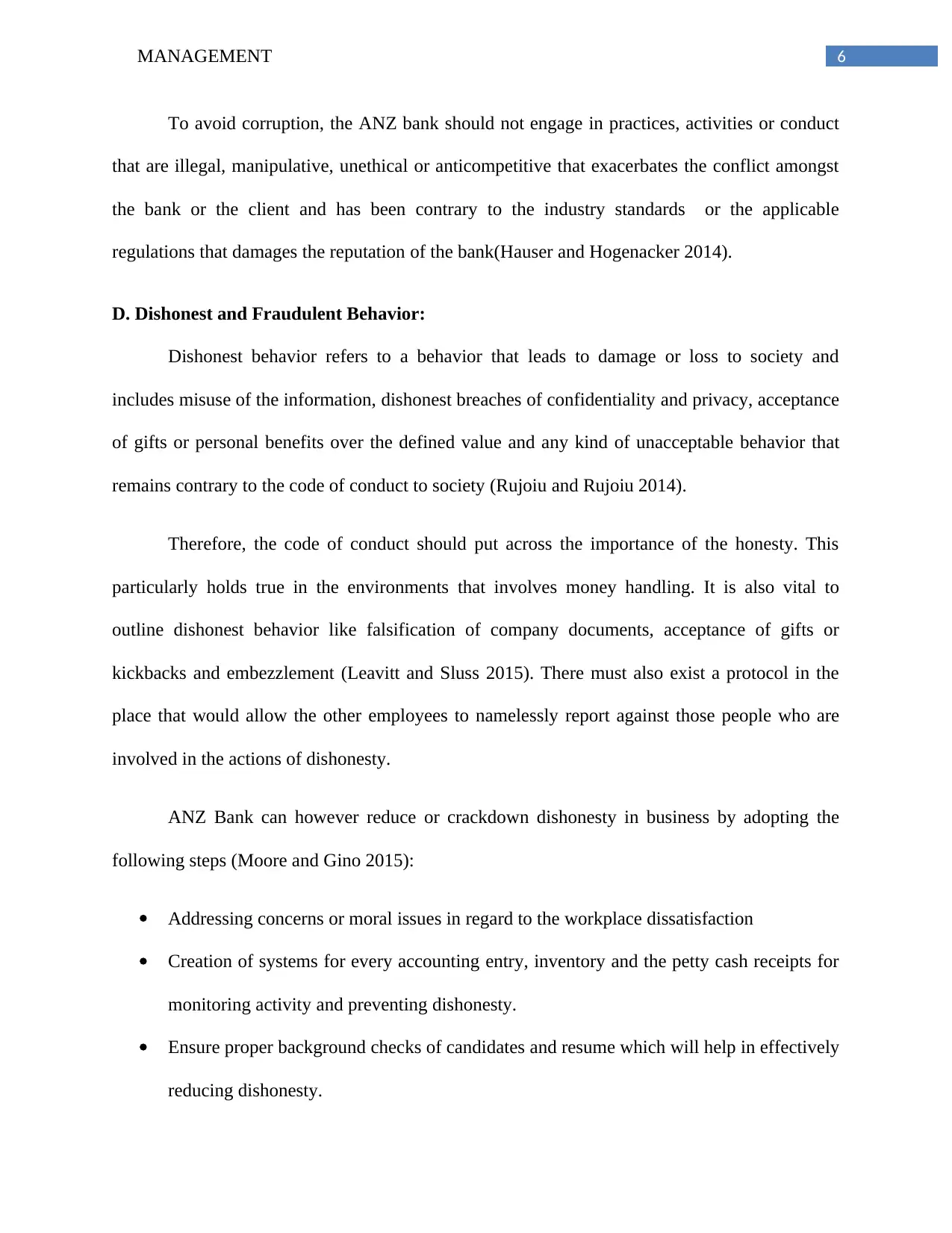
6MANAGEMENT
To avoid corruption, the ANZ bank should not engage in practices, activities or conduct
that are illegal, manipulative, unethical or anticompetitive that exacerbates the conflict amongst
the bank or the client and has been contrary to the industry standards or the applicable
regulations that damages the reputation of the bank(Hauser and Hogenacker 2014).
D. Dishonest and Fraudulent Behavior:
Dishonest behavior refers to a behavior that leads to damage or loss to society and
includes misuse of the information, dishonest breaches of confidentiality and privacy, acceptance
of gifts or personal benefits over the defined value and any kind of unacceptable behavior that
remains contrary to the code of conduct to society (Rujoiu and Rujoiu 2014).
Therefore, the code of conduct should put across the importance of the honesty. This
particularly holds true in the environments that involves money handling. It is also vital to
outline dishonest behavior like falsification of company documents, acceptance of gifts or
kickbacks and embezzlement (Leavitt and Sluss 2015). There must also exist a protocol in the
place that would allow the other employees to namelessly report against those people who are
involved in the actions of dishonesty.
ANZ Bank can however reduce or crackdown dishonesty in business by adopting the
following steps (Moore and Gino 2015):
Addressing concerns or moral issues in regard to the workplace dissatisfaction
Creation of systems for every accounting entry, inventory and the petty cash receipts for
monitoring activity and preventing dishonesty.
Ensure proper background checks of candidates and resume which will help in effectively
reducing dishonesty.
To avoid corruption, the ANZ bank should not engage in practices, activities or conduct
that are illegal, manipulative, unethical or anticompetitive that exacerbates the conflict amongst
the bank or the client and has been contrary to the industry standards or the applicable
regulations that damages the reputation of the bank(Hauser and Hogenacker 2014).
D. Dishonest and Fraudulent Behavior:
Dishonest behavior refers to a behavior that leads to damage or loss to society and
includes misuse of the information, dishonest breaches of confidentiality and privacy, acceptance
of gifts or personal benefits over the defined value and any kind of unacceptable behavior that
remains contrary to the code of conduct to society (Rujoiu and Rujoiu 2014).
Therefore, the code of conduct should put across the importance of the honesty. This
particularly holds true in the environments that involves money handling. It is also vital to
outline dishonest behavior like falsification of company documents, acceptance of gifts or
kickbacks and embezzlement (Leavitt and Sluss 2015). There must also exist a protocol in the
place that would allow the other employees to namelessly report against those people who are
involved in the actions of dishonesty.
ANZ Bank can however reduce or crackdown dishonesty in business by adopting the
following steps (Moore and Gino 2015):
Addressing concerns or moral issues in regard to the workplace dissatisfaction
Creation of systems for every accounting entry, inventory and the petty cash receipts for
monitoring activity and preventing dishonesty.
Ensure proper background checks of candidates and resume which will help in effectively
reducing dishonesty.
Paraphrase This Document
Need a fresh take? Get an instant paraphrase of this document with our AI Paraphraser
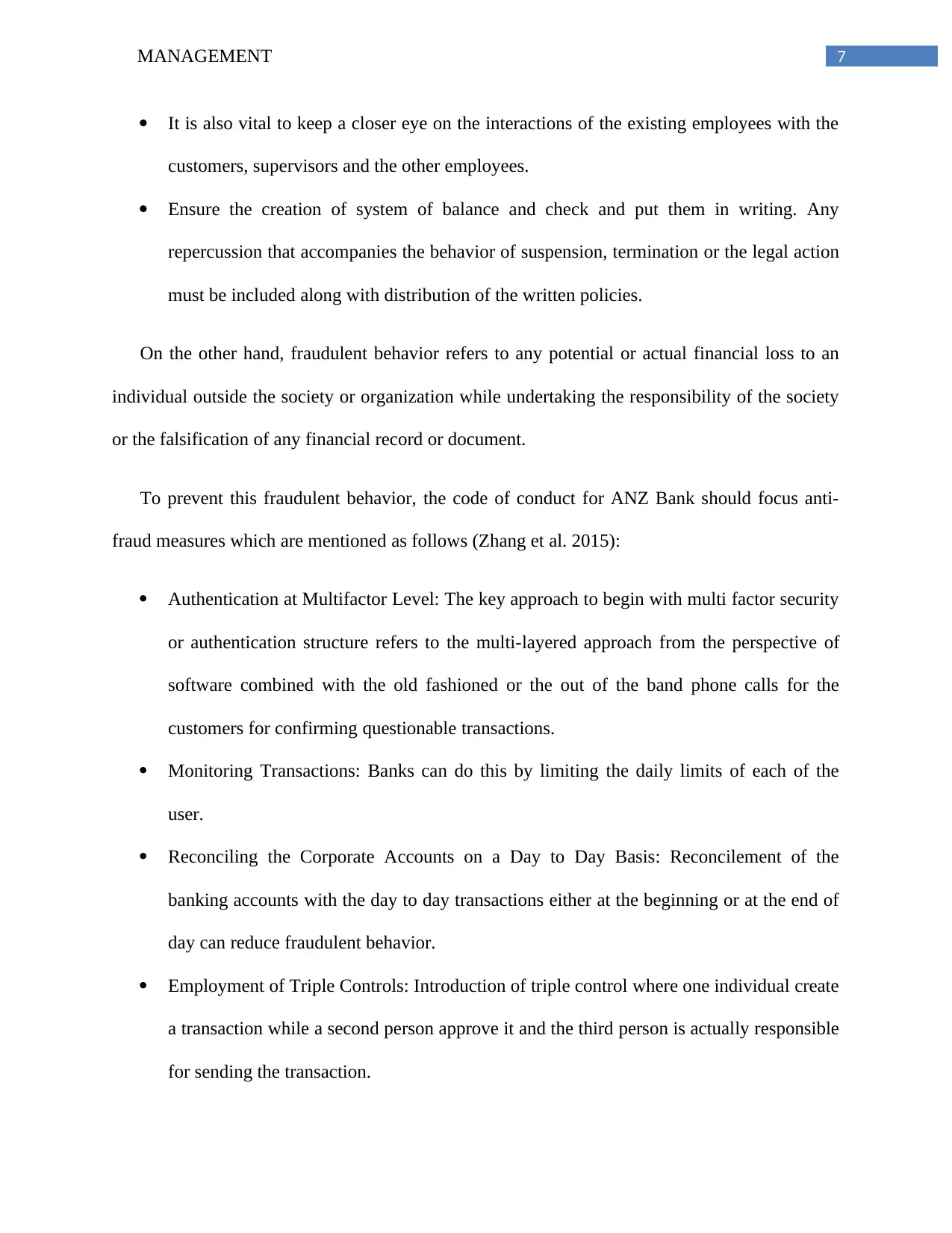
7MANAGEMENT
It is also vital to keep a closer eye on the interactions of the existing employees with the
customers, supervisors and the other employees.
Ensure the creation of system of balance and check and put them in writing. Any
repercussion that accompanies the behavior of suspension, termination or the legal action
must be included along with distribution of the written policies.
On the other hand, fraudulent behavior refers to any potential or actual financial loss to an
individual outside the society or organization while undertaking the responsibility of the society
or the falsification of any financial record or document.
To prevent this fraudulent behavior, the code of conduct for ANZ Bank should focus anti-
fraud measures which are mentioned as follows (Zhang et al. 2015):
Authentication at Multifactor Level: The key approach to begin with multi factor security
or authentication structure refers to the multi-layered approach from the perspective of
software combined with the old fashioned or the out of the band phone calls for the
customers for confirming questionable transactions.
Monitoring Transactions: Banks can do this by limiting the daily limits of each of the
user.
Reconciling the Corporate Accounts on a Day to Day Basis: Reconcilement of the
banking accounts with the day to day transactions either at the beginning or at the end of
day can reduce fraudulent behavior.
Employment of Triple Controls: Introduction of triple control where one individual create
a transaction while a second person approve it and the third person is actually responsible
for sending the transaction.
It is also vital to keep a closer eye on the interactions of the existing employees with the
customers, supervisors and the other employees.
Ensure the creation of system of balance and check and put them in writing. Any
repercussion that accompanies the behavior of suspension, termination or the legal action
must be included along with distribution of the written policies.
On the other hand, fraudulent behavior refers to any potential or actual financial loss to an
individual outside the society or organization while undertaking the responsibility of the society
or the falsification of any financial record or document.
To prevent this fraudulent behavior, the code of conduct for ANZ Bank should focus anti-
fraud measures which are mentioned as follows (Zhang et al. 2015):
Authentication at Multifactor Level: The key approach to begin with multi factor security
or authentication structure refers to the multi-layered approach from the perspective of
software combined with the old fashioned or the out of the band phone calls for the
customers for confirming questionable transactions.
Monitoring Transactions: Banks can do this by limiting the daily limits of each of the
user.
Reconciling the Corporate Accounts on a Day to Day Basis: Reconcilement of the
banking accounts with the day to day transactions either at the beginning or at the end of
day can reduce fraudulent behavior.
Employment of Triple Controls: Introduction of triple control where one individual create
a transaction while a second person approve it and the third person is actually responsible
for sending the transaction.
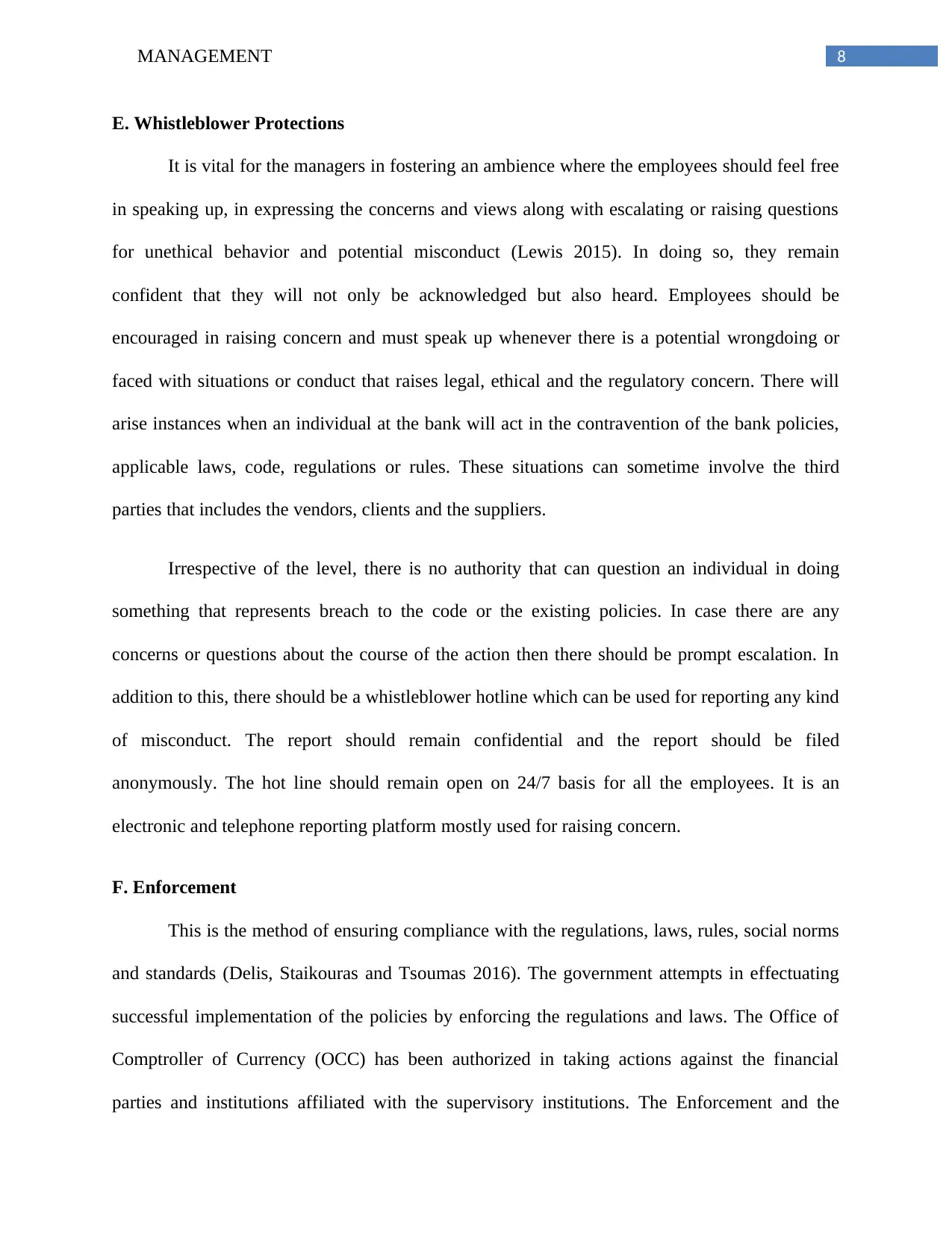
8MANAGEMENT
E. Whistleblower Protections
It is vital for the managers in fostering an ambience where the employees should feel free
in speaking up, in expressing the concerns and views along with escalating or raising questions
for unethical behavior and potential misconduct (Lewis 2015). In doing so, they remain
confident that they will not only be acknowledged but also heard. Employees should be
encouraged in raising concern and must speak up whenever there is a potential wrongdoing or
faced with situations or conduct that raises legal, ethical and the regulatory concern. There will
arise instances when an individual at the bank will act in the contravention of the bank policies,
applicable laws, code, regulations or rules. These situations can sometime involve the third
parties that includes the vendors, clients and the suppliers.
Irrespective of the level, there is no authority that can question an individual in doing
something that represents breach to the code or the existing policies. In case there are any
concerns or questions about the course of the action then there should be prompt escalation. In
addition to this, there should be a whistleblower hotline which can be used for reporting any kind
of misconduct. The report should remain confidential and the report should be filed
anonymously. The hot line should remain open on 24/7 basis for all the employees. It is an
electronic and telephone reporting platform mostly used for raising concern.
F. Enforcement
This is the method of ensuring compliance with the regulations, laws, rules, social norms
and standards (Delis, Staikouras and Tsoumas 2016). The government attempts in effectuating
successful implementation of the policies by enforcing the regulations and laws. The Office of
Comptroller of Currency (OCC) has been authorized in taking actions against the financial
parties and institutions affiliated with the supervisory institutions. The Enforcement and the
E. Whistleblower Protections
It is vital for the managers in fostering an ambience where the employees should feel free
in speaking up, in expressing the concerns and views along with escalating or raising questions
for unethical behavior and potential misconduct (Lewis 2015). In doing so, they remain
confident that they will not only be acknowledged but also heard. Employees should be
encouraged in raising concern and must speak up whenever there is a potential wrongdoing or
faced with situations or conduct that raises legal, ethical and the regulatory concern. There will
arise instances when an individual at the bank will act in the contravention of the bank policies,
applicable laws, code, regulations or rules. These situations can sometime involve the third
parties that includes the vendors, clients and the suppliers.
Irrespective of the level, there is no authority that can question an individual in doing
something that represents breach to the code or the existing policies. In case there are any
concerns or questions about the course of the action then there should be prompt escalation. In
addition to this, there should be a whistleblower hotline which can be used for reporting any kind
of misconduct. The report should remain confidential and the report should be filed
anonymously. The hot line should remain open on 24/7 basis for all the employees. It is an
electronic and telephone reporting platform mostly used for raising concern.
F. Enforcement
This is the method of ensuring compliance with the regulations, laws, rules, social norms
and standards (Delis, Staikouras and Tsoumas 2016). The government attempts in effectuating
successful implementation of the policies by enforcing the regulations and laws. The Office of
Comptroller of Currency (OCC) has been authorized in taking actions against the financial
parties and institutions affiliated with the supervisory institutions. The Enforcement and the
⊘ This is a preview!⊘
Do you want full access?
Subscribe today to unlock all pages.

Trusted by 1+ million students worldwide
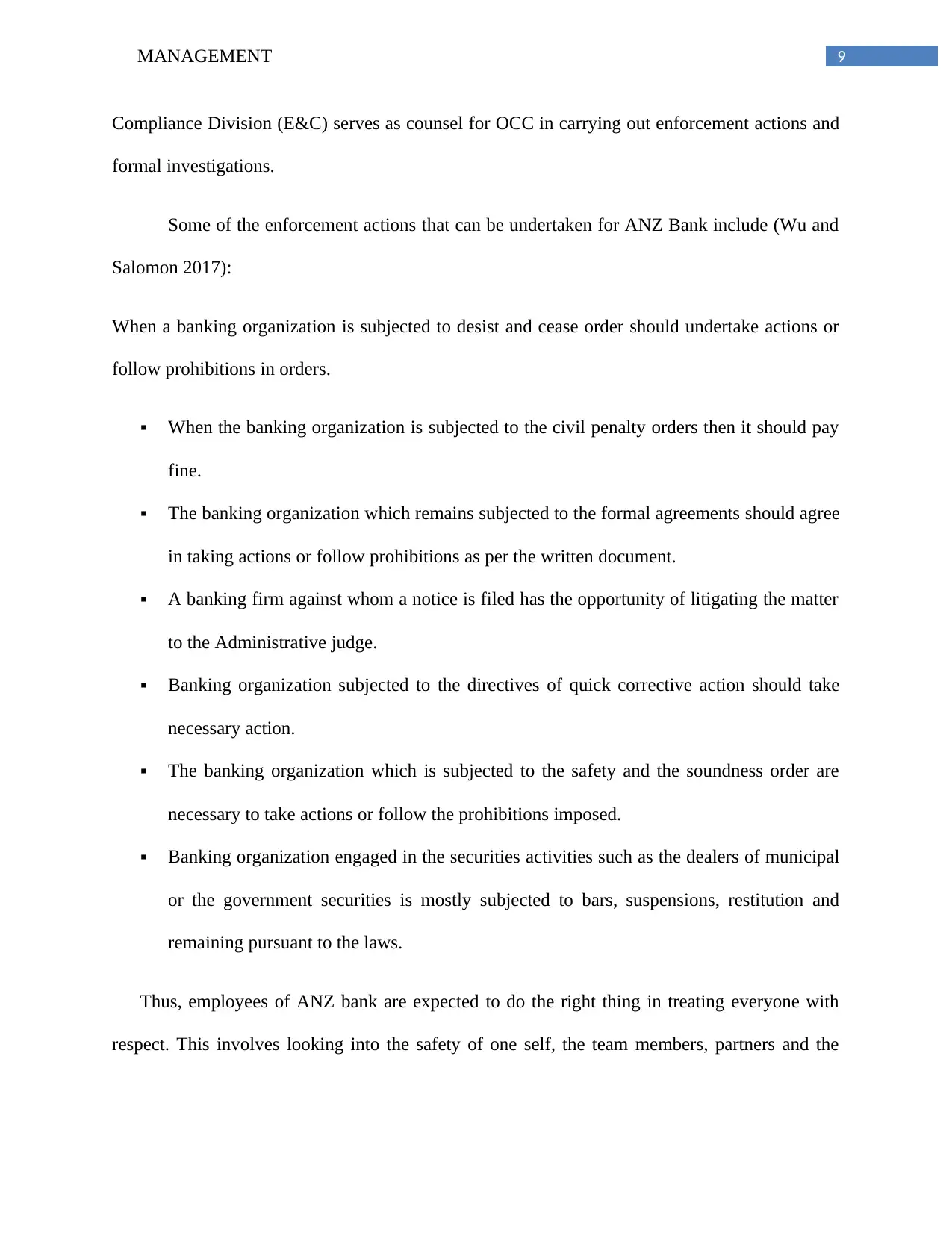
9MANAGEMENT
Compliance Division (E&C) serves as counsel for OCC in carrying out enforcement actions and
formal investigations.
Some of the enforcement actions that can be undertaken for ANZ Bank include (Wu and
Salomon 2017):
When a banking organization is subjected to desist and cease order should undertake actions or
follow prohibitions in orders.
When the banking organization is subjected to the civil penalty orders then it should pay
fine.
The banking organization which remains subjected to the formal agreements should agree
in taking actions or follow prohibitions as per the written document.
A banking firm against whom a notice is filed has the opportunity of litigating the matter
to the Administrative judge.
Banking organization subjected to the directives of quick corrective action should take
necessary action.
The banking organization which is subjected to the safety and the soundness order are
necessary to take actions or follow the prohibitions imposed.
Banking organization engaged in the securities activities such as the dealers of municipal
or the government securities is mostly subjected to bars, suspensions, restitution and
remaining pursuant to the laws.
Thus, employees of ANZ bank are expected to do the right thing in treating everyone with
respect. This involves looking into the safety of one self, the team members, partners and the
Compliance Division (E&C) serves as counsel for OCC in carrying out enforcement actions and
formal investigations.
Some of the enforcement actions that can be undertaken for ANZ Bank include (Wu and
Salomon 2017):
When a banking organization is subjected to desist and cease order should undertake actions or
follow prohibitions in orders.
When the banking organization is subjected to the civil penalty orders then it should pay
fine.
The banking organization which remains subjected to the formal agreements should agree
in taking actions or follow prohibitions as per the written document.
A banking firm against whom a notice is filed has the opportunity of litigating the matter
to the Administrative judge.
Banking organization subjected to the directives of quick corrective action should take
necessary action.
The banking organization which is subjected to the safety and the soundness order are
necessary to take actions or follow the prohibitions imposed.
Banking organization engaged in the securities activities such as the dealers of municipal
or the government securities is mostly subjected to bars, suspensions, restitution and
remaining pursuant to the laws.
Thus, employees of ANZ bank are expected to do the right thing in treating everyone with
respect. This involves looking into the safety of one self, the team members, partners and the
Paraphrase This Document
Need a fresh take? Get an instant paraphrase of this document with our AI Paraphraser
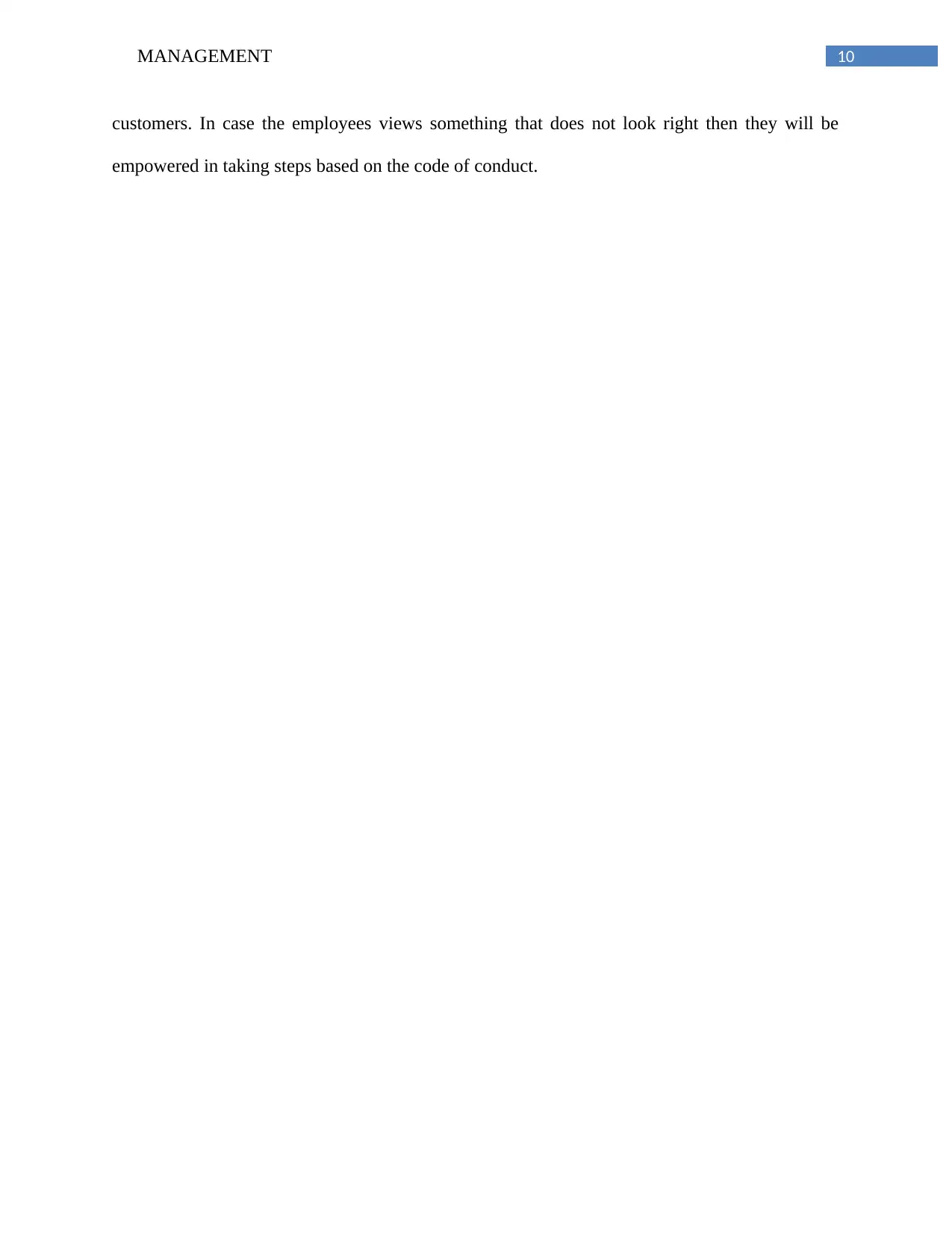
10MANAGEMENT
customers. In case the employees views something that does not look right then they will be
empowered in taking steps based on the code of conduct.
customers. In case the employees views something that does not look right then they will be
empowered in taking steps based on the code of conduct.
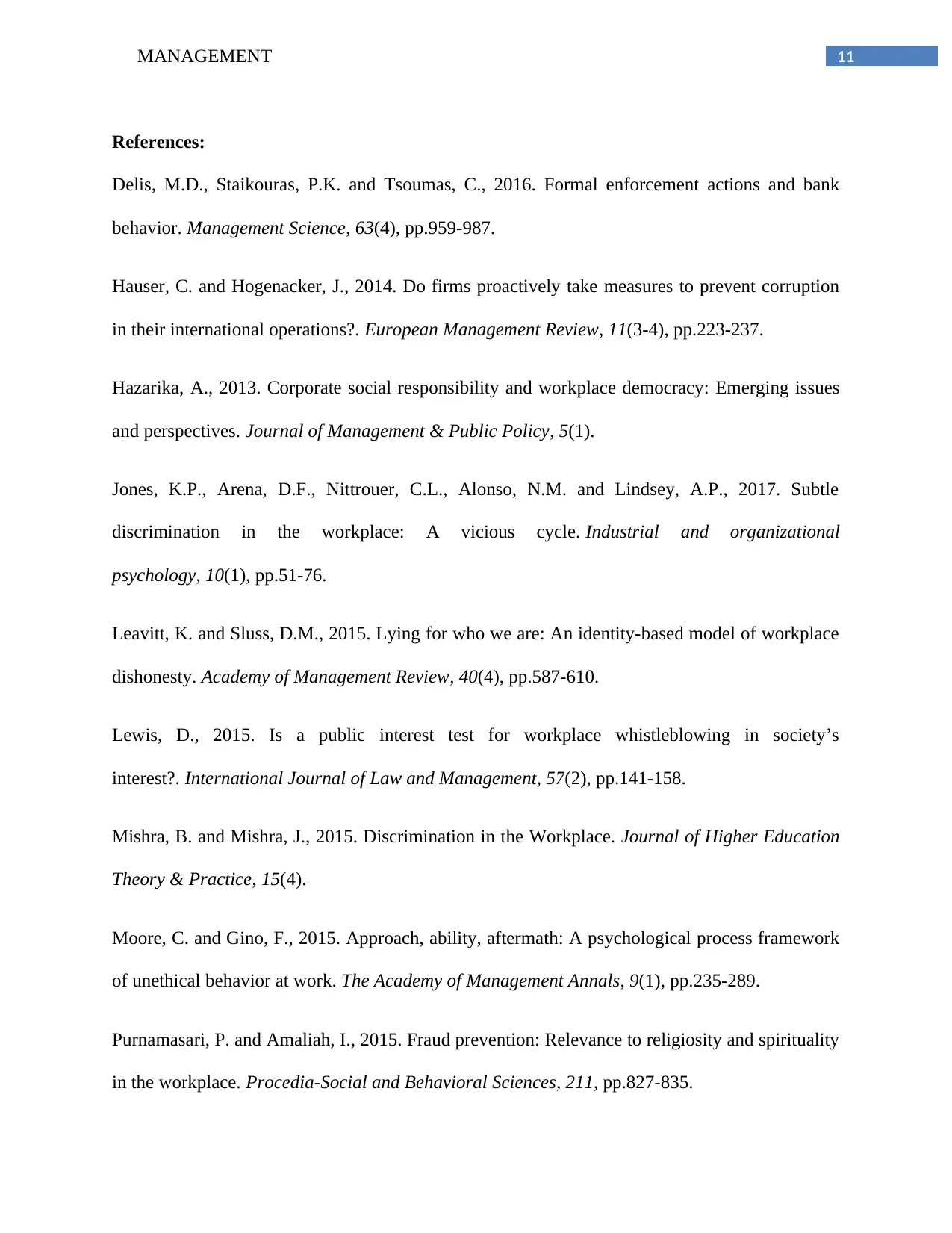
11MANAGEMENT
References:
Delis, M.D., Staikouras, P.K. and Tsoumas, C., 2016. Formal enforcement actions and bank
behavior. Management Science, 63(4), pp.959-987.
Hauser, C. and Hogenacker, J., 2014. Do firms proactively take measures to prevent corruption
in their international operations?. European Management Review, 11(3-4), pp.223-237.
Hazarika, A., 2013. Corporate social responsibility and workplace democracy: Emerging issues
and perspectives. Journal of Management & Public Policy, 5(1).
Jones, K.P., Arena, D.F., Nittrouer, C.L., Alonso, N.M. and Lindsey, A.P., 2017. Subtle
discrimination in the workplace: A vicious cycle. Industrial and organizational
psychology, 10(1), pp.51-76.
Leavitt, K. and Sluss, D.M., 2015. Lying for who we are: An identity-based model of workplace
dishonesty. Academy of Management Review, 40(4), pp.587-610.
Lewis, D., 2015. Is a public interest test for workplace whistleblowing in society’s
interest?. International Journal of Law and Management, 57(2), pp.141-158.
Mishra, B. and Mishra, J., 2015. Discrimination in the Workplace. Journal of Higher Education
Theory & Practice, 15(4).
Moore, C. and Gino, F., 2015. Approach, ability, aftermath: A psychological process framework
of unethical behavior at work. The Academy of Management Annals, 9(1), pp.235-289.
Purnamasari, P. and Amaliah, I., 2015. Fraud prevention: Relevance to religiosity and spirituality
in the workplace. Procedia-Social and Behavioral Sciences, 211, pp.827-835.
References:
Delis, M.D., Staikouras, P.K. and Tsoumas, C., 2016. Formal enforcement actions and bank
behavior. Management Science, 63(4), pp.959-987.
Hauser, C. and Hogenacker, J., 2014. Do firms proactively take measures to prevent corruption
in their international operations?. European Management Review, 11(3-4), pp.223-237.
Hazarika, A., 2013. Corporate social responsibility and workplace democracy: Emerging issues
and perspectives. Journal of Management & Public Policy, 5(1).
Jones, K.P., Arena, D.F., Nittrouer, C.L., Alonso, N.M. and Lindsey, A.P., 2017. Subtle
discrimination in the workplace: A vicious cycle. Industrial and organizational
psychology, 10(1), pp.51-76.
Leavitt, K. and Sluss, D.M., 2015. Lying for who we are: An identity-based model of workplace
dishonesty. Academy of Management Review, 40(4), pp.587-610.
Lewis, D., 2015. Is a public interest test for workplace whistleblowing in society’s
interest?. International Journal of Law and Management, 57(2), pp.141-158.
Mishra, B. and Mishra, J., 2015. Discrimination in the Workplace. Journal of Higher Education
Theory & Practice, 15(4).
Moore, C. and Gino, F., 2015. Approach, ability, aftermath: A psychological process framework
of unethical behavior at work. The Academy of Management Annals, 9(1), pp.235-289.
Purnamasari, P. and Amaliah, I., 2015. Fraud prevention: Relevance to religiosity and spirituality
in the workplace. Procedia-Social and Behavioral Sciences, 211, pp.827-835.
⊘ This is a preview!⊘
Do you want full access?
Subscribe today to unlock all pages.

Trusted by 1+ million students worldwide
1 out of 13
Related Documents
Your All-in-One AI-Powered Toolkit for Academic Success.
+13062052269
info@desklib.com
Available 24*7 on WhatsApp / Email
![[object Object]](/_next/static/media/star-bottom.7253800d.svg)
Unlock your academic potential
Copyright © 2020–2025 A2Z Services. All Rights Reserved. Developed and managed by ZUCOL.




